telegraphic codes and message practice |
|||
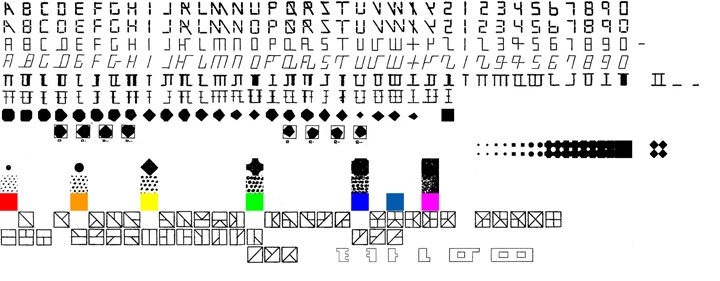
|
|
The material on elementary signs : pictures has been divided into two sections in order to shorten loadtime. The first section — on this page — provides an introduction followed by entries on patents and ideas from the period 1910-1924, emphasizing human analysis of images, and mechanical printing by lead types or typewriter. The second section, at pictures 2, is devoted to slightly later — though still transitional — developments in photo and facsimile telegraphy from the mid-1920s into the 1930s. The latter patents explicitly assume the use of selenium photocells and tuned relays, and generally offer a more complete and integrated "package" of the many processes involved : analysis, coding, tape punching and transmitting at the sending station, and printing and related processes at the receiving station. Yet some of these later systems — including Korn and early Bartlane — involved typewriters and even lead type.
|
|
elementary signs : pictures
elemental types UK Patent No 658 (1908)
UK Patent No 15,734 (1910), Austria Patentschrift No 49753 (1911)
UK Patent No. 7280 (1912) UK Patent No. 24,758 (1912) UK Patent No. 15,273 (1914) |
UK Patent No 190,522 (1922)
UK Patent No. 178,145 (1922) UK Patent No. 183,135 (1923) pictures 2 (separate page)
automated scrambled pictures (image ciphering) telautography (separate page)
|
Early decades of the 20th Century saw different paths taken in the development of copying telegraphy, telautography, or what we would today call facsimile telegraphy. In all cases, an original image needed to be "explored." In "direct" methods, the varying current generated by the exploration was essentially sent as a modulated signal across wire or wireless telephone circuits, for reproduction at the receiving end. "Indirect" methods involved "analysis" of the original image as part of the exploration, either by human eye or photoelectric cell; coding thereof; and transmission of the coded information as telegraph signals. A reversal of the process would happen at the receiving end : decoding and reconstitution of the image. These notes focus on patents relating to indirect methods, and more narrowly to analysis and coding. Methods discussed on this page precede integrated, automated systems, and involve human operators in the analysis and classification of an image, one area at a time, into its grayscale values. And under our heading "elementary signs", we are concerned with the relationship of those classifications to means of reproducing the image, that included even the proposed use of lead types. Nomenclature can be confusing. Distinctions are sometimes forcefully made between "telautography" and "copying telegraphy," for example. Yet the Bartlane patents use the two terms interchangeably (most notably in the U.S. and British versions of the same specifications). For a review of some of the patent literature on this telegraphic margin, see margins : telautography. I refer to it as a margin because it was a form of direct transmission, using neither code nor intermediate record. No attempt is made here at even a thumbnail history of facsimile telegraphy. It is undeniable however that a confluence of technical developments —photocells, printing telegraphy, electronics (rheostats, etc.) — plus the newspaper appetite for photographs in the wake of the transition to halftone processes, together encouraged multiple strands of development in the early twentieth century. Let Armagnat (1908) set the stage : The transmission of pictures to a distance by electrical current is not a new idea. It had its inception perhaps some thirty years ago when electricity itself was developing, and even then furnished ground for hopes which are to-day partially fulfilled. The invention of the photophone by Graham Bell had made generally known the sensitiveness to light of selenium, and its utilization for the transmission of pictures was at once proposed by many. Indeed, during the last thirty years no further advance has been made in the direct reproduction at a distance of the images of real animate objects. ¶ But if we restrict our problem to requiring electricity to send and reproduce, point by point, an inanimate picture, we shall find several interesting solutions, some of which have had practical trials and require but little further development to be commercially practicable whenever a demand for phototelegraphy grows. ¶ The transmission of pictures containing only blacks and whites without any half-tones was tried in 1851 by Backwell [sic], in 1855 by Caselli, and finally by d'Arlincourt in 1872. All these inventors had in view not the sending of a picture, but the transmission of writing. Their purpose was to send autographs by means of the telegraph, but they naturally could have reproduced equally well other pen designs. As the phototelegraphy of to-day still embodies these early ideas, it is really no innovation. The passage highlighted in red would direct us to telautography for one, but also alert us to uncertainty about the nature of letters — picture vs symbol — that is never far from the surface in ideas about printing and picture telegraphy presented in these pages. For overviews and contemporary surveys, see
Telegraphy offered numerous means by which "visual" information might be expressed; only some of those means are described here. For example, the quality, condition, classification and other features of a sample bale of cotton or hemp might be described — with very fine shadings — by means of a series of tables. Astronomical and meteorological observations, fingerprints, criminal physiognomies, articles of clothing, cigar mold shapes — all of these had their code dictionaries. These means of structured description resembled Dewey Decimal assignments; their topic/subtopic/sub-sub topic format was a kind of "folksonomic" faceted classification system. They were semantic in a way that the elemental types described here for picture telegraphy are not; yet all of these means of classification and communication coexisted. Semantic classification schemes for images are another more recent connection to telegraphic code dictionaries — or thesauruses. One example is Iconclass, a "subject specific international classification system for iconographic research and the documentation of images" developed by Henri van de Waal (1910-1972). The observer may detect hints or echoes of Malevich in the Montagna drawings, or find analogues with cubism in patents and devices devoted to scrambling and reconstruction of an image (e.g., 1922 GB 153,597, 1931 GB 354,249 or the later 1951 GB 655,320). Art and literary historians are wont to find analogues in the frontiers of science. Yet the connections might be closer at hand, in the engineered machinery of daily life and commerce. This survey of elementary signs in telegraphy remains fluid, subject to change. These constitute visual notes on a varied body of material, in which visuals can be kept near my annotations, and all can be reorganized easily. There is quite a bit of technical minutiae here, yet it is only the tiniest sample of what resides in these patents. |
The employment of lead types for printing pictures preceded copying telegraphy, perhaps most dramatically in the "stigmatypie" displayed in Carl Fasol (1815-1892) his Album der Buchdruckerkunst (in two series — 1: 1868-1881 and 2: 1884-88), but also evidenced in crochet and other specialized type shown in divers printers' specimen books. These earlier instances were more a display of compositor ingenuity than an economical practice. But earlier practitioners were onto something important: because sequences of pixel-like elements lent themselves to easy coding and transmission, the idea was taken up in telegraphy as an alternative to non-coded scans requiring synchronized systems. Other methods of pictorial reproduction — primarily photochemical but also involving heat-sensitive paper, and even specially-designed typewriters and teletype machines — would obviate "pictorial" printing types. The type schemes were a kind of "holding pattern", a blackbox idea for part of the system that needed to await developments in photocells, tube amplifiers, lens and other mechanisms. They interest us now for the solutions they offer to image analysis of value and edges (borders between areas of different values and hues, addressed now in antialiasing).
|
UK Patent No 658
|
Improvements in or relating to the Reproduction of Pictures, Drawings, & the like, at a Distance |
Amalgamated Radio-Telegraph Company (London) and Nevil Maskelyne (Langham Place, London) |
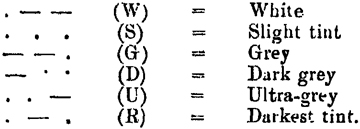
|
"Considering now the reconstruction of the picture at the receiving station, we preferably employ some form of typographic process capable of reproducing, at will, each of the standard tints, arranged in proper sequence. But photographic or other methods of reproduction would answer equally well although the probably would be less convenient. In fact, any method whereby suitably-tinted squares may be arranged in definite order may be used. We prefer, however, the typographic method on account of its simplicity. "Using this method, we construct type, the faces of which are respectively fashioned so as to give impressions corresponding to the six standard tints already described. This may readily be done by forming the type-faces into lines varying in number and thickness according to the shade desired or by forming the said type faces so as to produce various sizes of dots. Such type may be produced in quantities and set up in the ordinary manner; or, if preferred, they may be attached to a simple form of type-writing machine, and operated by the usual finger-keys. In either case, they are caused to produce regularly spaced and properly arranged impressions, corresponding to the variously tinted subdivisions of the original picture. These printed tints need not be upon so large a scale as the squares upon the magnified photography, picture, or the like, used at the transmitting station. Type faces one eight of an inch square are large enough." (5:17ff) |
"We commence by making a photographic enlargement of the picture to be telegraphed, the magnification being twenty diameters if the picture is small. Such an enlargement may be completed in a few minutes, at a trifling cost. Upon this enlarged picture we lay a transparent sheet of tissue, divided by horizontal and vertical lines into spaces, say, one-quarter of an inch square. This being done, it becomes evident that, to all intents and purposes, the small portion of the picture enclosed by any one of the subdividing squares constitutes an evenly tinted surface. Further, it is seen that, from the deepest black of the picture to the purest white of the paper, the recognizable degrees of tint are cetaintly not more than six in number. If, therefore, we take the square sub-divisions in regular succession, from left to right and line after line, marking upon each the numerical value of the tint within it, we obtain a series of values which may be telegraphed to any distant point, and there be reproduced with certainty." (4:31ff) |
Maskelyne's specification provides the principles but leaves out all of the details that will soon matter : scanning by photoelectric cell being only the most obvious. Nor does he treat in a practical way output, either by photographic process or type, whether lead sorts or typewriter faces. The key principles are : a limited number of tints or shades (six is sufficient), each identified by a code. Maskelyne uses a three-unit code that looks like but isn't Morse, and that is sufficient to identify all of his shades. Indeed, his system does not employ two of the eight possible "meanings", that might be used, say, for carriage return or some other instruction. His code also contains no means of counting and coding sequences of same-shade units, to shorten transmission time. Nevil Maskelyne — identified in this patent as an Electrical Engineer — is presumably the son of John Nevil Maskelyne (1839-1917), a noted magician, impressario, debunker of spiritualism, and inventor. For the latter capacity, the father is known for the the Maskelyne Typewriter (1893). Two related patents assigned to John Nevil Maskelyne, Jr. (Mechanician, of The Egyptian Hall, London in the first, and Gentleman, same address in the second) are 1900 GB 23,549 (Improvements in and relating to Telegraphic Transmitting Apparatus) and 1895 GB 2513 (Improvements relating to the Production of Type). The former relates to wireless telegraphy, specifically to a "traveller" device in a telegraphic transmitting apparatus "that is intended for the transmission of fixed signals, such as the name of a ship or of a lighthouse, or a danger or signaling station." The 1895 specification relates to type for the typewriter (the special demands of casting three characters on a single type block). Our Nevil Maskelyne is descended from the astronomer royal Nevil Maskelyne (1732-1811), according to the DNB biography on John Nevil Maskelyne. Additional information about the Maskelynes can be found at the adventures in cybersound archive. See also Sungook Hong's Wireless: From Marconi's Black-Box to the Audion (MIT Press, 2001) for "the full story of the infamous 1903 incident in which Marconi's opponent Nevil Maskelyne interfered with Fleming's public demonstration of Marconi's syntonic (tuning) system at the Royal Institution by sending derogatory messages from his own transmitter." (Maskelyne set up his own instruments in his own Egyptian Hall!)
|
UK Patent No 15,734
|
Improvements in or relating to the Telegraphic and Telephonic Transmission of Pictures |
Antonio Montagna (gentleman, Rome) |
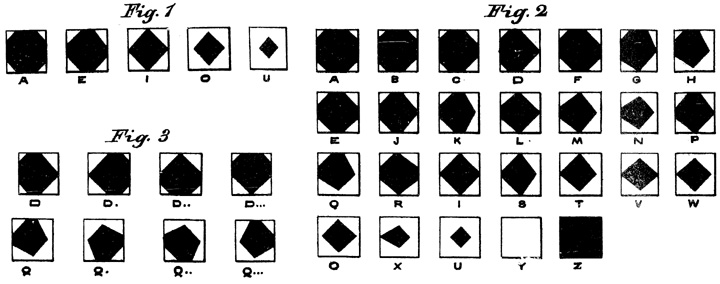
|
|
|
figures 1-3 from Österreichische Patentschrift Nr. 49753 (application 5 November 1910; assigned 15 April 1911) |
|
Montagna begins the English (but not Austrian) specification for a system of "iconotelegrams" by connecting the present invention to a tradition that goes back to Leonardo da Vinci, whose "so-called 'spoken portrait'" proposed the transmission of pictures by "conventional signs." The new system is presented as an alternative to selenium cell and other systems, and its primary merit is the exclusion of "analytic work depending from the personal judgment of the operator." The division of a photographically enlarged picture into a network of squares, it is claimed, "presents to the eye of the spectator, a dot of well determined form or shape." Twenty-five different shapes are proposed, these being derivations of five "prototypical figures" shown in figure 1 above. A further variation is shown in figure 3, where a primary figure is shown in four orientations (90, 180 and 270 degrees). It is with these types that the receiver prints the picture, one square at a time. Some message condensation can be achieved by indicating by a single cipher a sequence of squares requiring identical symbols. The proposed 25 different shapes conveniently correspond to the number of letters of the ordinary alphabet. "A sufficient supply of printing characters corresponding to the image-constituting symbols may for instance be kept in the compartments of an ordinary typographic letter-case, or type-setting or linotype machines may be used for the purpose." |

|
|
"image analysed into its constituent elements" (fig 4); "printing character" (fig 5); all from Österreichische Patentschrift Nr. 49753 "a very simple telegram (or telephonogram) where the transmitted alphabetical letters translated with the aid of the cipher-key form together an ornamental figure commonly known as a Meander." (fig. 6). text from 1910 GB 15,734 (3:20ff) Z black, Y white. Figures follow the indicated color. The coded message ignores the outline rows and columns; the grid is 9 by 9 squares. |
|
|
The system does seem to require subjective judgment by the operator — perhaps less arduous than what was achieved by LeBlon in his three color separations. Most remarkable here might be Montagna's provision of the four different orientations ("locations") on the printing type, to better represent edges within pictures. We will see further development of this idea in the Ellero patents described further below. Montagna's coded example (Fig. 6) is not as efficient as various of the Bartlane means described in the second of these pages on elementary signs : pictures. Montagna is cited in Gaynor's UK Patent Specification 190,522 of 1922.
|
UK Patent No 7280
|
A System of Analysis, Interpretation, Figured Registration and Reconstitution of Designs, Pictures, and the like. |
Paul Mortier (civil engineer, Paris) |
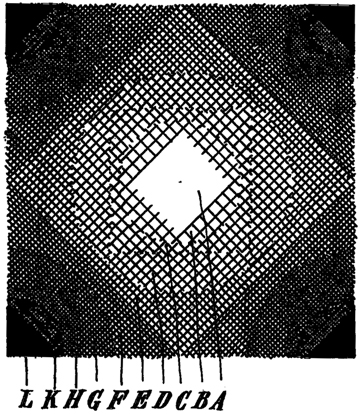
|
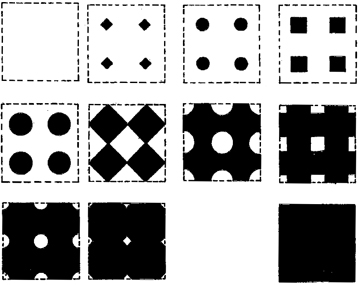
|
"The surface of the image to be sectioned and interpreted is obtained as a positive from a transparent photographic negative of the image by interposing between the latter and the sensitized surface the sectioning screen the meshes of which consist of zones of scaled or graded transparency. The resulting proof, if printed with a view to obtaining maximum contrast between the black and the white parts thereof, will be a sectioned positive of the image..." (2:19ff) Ten exposures are taken of a single image — each exposure for a different "energy" (hence, time) — and each one providing a separate high-contrast print. The exposures are taken through a mesh or screen, whose shapes are shown above right. |
"For a series of exposures of different energy, a series of forms such as are shown in Figure 2 [above] would result, each of the forms representing not only the appearance of the unitary elements, but also of neighboring parts of similar contiguous elements supposed to form a net work of multiple meshes." (3:14ff) |

|
|
|
"Figure 4 represents by way of example and on a large scale, the face forms of type designed to reproduce the sequences 1, 2, 5, and 10, in three different tonalities." (5:42ff) |
|
Patent No 7280 of 1912 is listed among the patents in the appendix to L.A. Legros and John Cameron Grant their unjustly neglected Typographic Printing-Surfaces (1916). Mortier himself is associated with patents for cinematography and color separations, and only here (indirectly) for telegraphy. Yet as Mortier writes, "As the documentary figured text recording the results of the analysis can be transmitted by telegraph, the entire described process constitutes the most simple and most practical telephotographic system." Mortier begins with a majestically broad-scoped characterization of his system: This invention relates to the decomposition of original images into elements sectioned by chequering and their material reconstitution by suitably shaded contiguous elements. This system or process has long been practiced in the weaving, tapestry, and mosaic arts, and the industiral generalisation of this method of analysis and synthesis has also been proposed and consists in a special form, known as the statistic form, in which the estimation of the shade proper to each element, instead of being immediately materialized, is, in a transitory way, translated by a literal or a numbered notation. The whole of these notations constitutes a symbolic text, from which the reconstitution of the original can afterwards be effected, in the absence of any such original, by means of parallelopiped shaped type with square faces imparting the corresponding half tones, and afterwards reduced by photography and transferred on to zinc to form the printing surface. His system directly addresses shortcomings of prior systems:
The most important of Mortier's solutions involves the use of a screen, such as is shown above, for "decomposition" of an image into "zones". This is effected by a series of exposures of the original, through the screen at its ten (A-L) transparencies. "The appearance of the contrasted print or proof with clearly defined division allows of judging at a glance, by means of an order number, the relative energy of exposure employed and consequently of the intensity of the lighting acting during a given time." Leaving the "analysis" aside, the tones of respective zones are expressed by the figures 0, 1, 2, 3, 4, 5, 6, 7, 8 and 9. These can easily be expressed by symbolic text, even in condensed form. Thus, 35 26 77 86 would signify a frame of 20 analytical squares, three at gray 5, two gray 6, seven gray 7, followed by eight more gray 6. Mortier prescribes ten different faces, each with an X of different width and, to match the system for condensing data just described, ten different widths of each of those ten faces, e.g., 1, 2, 3, 4, 5, 6, 7, 8, 9 and 10 squares wide, hence a drawer with 100 faces. (The system might easily be accommodated by Linotype casters). Examples of several widths and values are shown above right. "This simple improvement reduces from 75 to 80 per cent. the number of units to be placed in a work for arriving at the same result." Mortier's system does seek to mechanize the analysis of value by use of a graduated screen arrangement; I do not know if it was actually employed. His method of condensation is identical to that of Gaynor (see below). There is not much evidence that Mortier is familiar with actual telegraphic working; his overconcern with "penumbra" (in-between areas not quite falling into one or another gray value) is problematic. Mortier's system looks forward to the Bartlane system which, in early manifestations, involved five separate plates made of the same original, each one exposed for a different value.
|
UK Patent No 24,758
|
Method for the Transmission of Photographs and other Pictures by Means of Ordinary Telegraph and Telephone Apparatus |
Umberto Ellero (police officer, Rome) |

|
|
|
|
Ellero breaks the process down into stages:
The analysis is performed upon an image that has been enlarged 7 - 10 times its original size. Ellero describes several photographic and mechanical means of dividing the image; far more important is his detailed description of how an analysis of shades might actually be performed : On the enlarged picture, or on the figure itself, it must be fixed in advance, by writing it even in pencil in order to remember, the value of some shades in the darker portion; suit, hat, eyebrows, etc.; gradually passing then from the darker shades to those less intense, and from the lighter shades to those more intense; thus reading the middle shade, which is indicated by the numeral -1-. In this classification of reference only the fundamental gradations are used, while the intermediate ones do not need to be indicated, as their use for obtaining a soft passage from one gradation to another is evident. After having prepared this general classification, the actual description of the image is begun by starting from the top row of quares, and writing successively all the numbers corresponding to the intensity of shades in the image covered by the successive squares. When all the numbers of the first row have been written, in a second line are written all the numbers, or symbols, corresponding to the shades in the second row of quares, and so on, until the image has been entirely described. It is necessary that these lines of symbols be disposed one under the other, and in such order that the symbols of the successive columns (vertical rows) be one under the other, so that the whole table of symbols become the symbolic representation of the real image even in position. This regular and well ordered position will render easy the simplifications which might be found convenient in the compilation of the telegram. Thus, for instance, when the squares of a row or of a column have the same intensity of shade, then instead of repeating many times the same symbol, an abbreviation can be used meaning the repetition of the symbol ; in these abbreviations, it is necessary to use only those signs allowed for in telegraphic service. After making the abbreviations, and after having written down the message, the translation work of the transmitting office is complete." We turn now to the elementary signs, and the types they form. Ellero distinguishes two levels here: 10 elementary signs (shown above), and then 9 types that are formed from these. He writes at 3:45ff that "In practice it has been found that 9 different gradations are sufficient to give an exact representation, and at the same time they are found convenient to the execution of the work, although said number may be either increased or diminished according to circumstances, and according to the character of the image to be reproduced." |
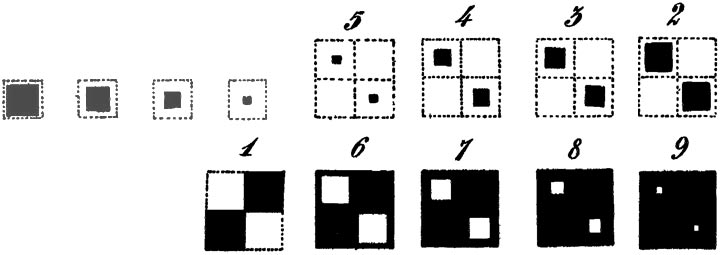
|
|
Elementary signs (a selection of five shown above, for comparision) and their combination in nine separate 4-unit types, are presented in the patent document at ten times the usual size. |
"These groups of elementary signs are symmetrical about their diagonals, but there are other combinations easy to be conceived, which however are not given here for brevity sake... by placing at the two sides of one of the diagonals, instead of two similar elementary signs, two signs corresponding to two successive degrees of shades, the value of the group resulting therefrom will be that of an intermediate shade standing between the two shades used." (5: 52ff) |
|
Ellero considers the different shapes of the types themselves, referencing the diagonal crosses of Mortier's 1912/7280, and devices in other previous patents. He chooses a white or black dot contained within grounds of their opposite colors, as shown above. Two subsequent patents present elaborations and variations on the elementary signs and their combinations in printing and typewriter types. Shown below are types combined to indicate shaded grounds. |

|
|
|
"Fig. 4 gives an example of 9 strips with the fundamental degrees of shades, which have been obtained with types formed of elements symmetrical to their diagonals." (5: 55ff) |
|
Ellero does not present photographic examples of his system, at least in this patent specification. He notes, regarding the reduction of photograph, that — "...when it is a question of transmitting pictures of criminals for legal use, it will be advisable to have the officers and the policemen well trained in giving a just appreciation of the distinguishing characters of physiognomy, as they are directly given by the enlarged picture." Ellero seems to mean that an expert should be on hand to ensure that important features are captured in the photographic reduction; he does not refer to Bertillon's signaletic system. Umberto Ellero's identification as "police officer" is an understatement; in addition to this patent, he authored several works in criminology and forensics, including
|
UK Patent No 15,273
|
Types for Typewriters and Typographical Setting Machines used in the Direct Reproduction of Images transmitted by means of ordinary Telegraphic Apparatus. |
Umberto Ellero (police officer, Rome) |
|
This specification is an extension from Ellero's 1912/24,758, conceived for a typewriter or an "automatical casting and setting machine." Fundamental types, figs 1 - 9, each squares of 16 spaces and 8 points; figs 1-3 black points on white ground; figs 4.-9 white points on black ground. Figs 10-19 yield the "secondary or transitional types... being formed by differently arranged points of the elements shown in Figs. 1 and 3. Fig. 20 shows diagrammatically a rectangular type with 12 points to be used in connection with automatical casting and setting machines; all of the points are indicated by figures bordered by curved surfaces, and in each type they are equal between each other, for it is the case of a fundamental type.
[ specimens to follow ]
|
UK Patent No 183,135
|
Improvements in the Transmission and Reproduction of Photographic Images by Means of the usual Telegraphic, Telephonic and Radiotelegraphic Apparatus. |
Umberto Ellero (police officer) and Pietro Ellero (engineer, both Rome) |
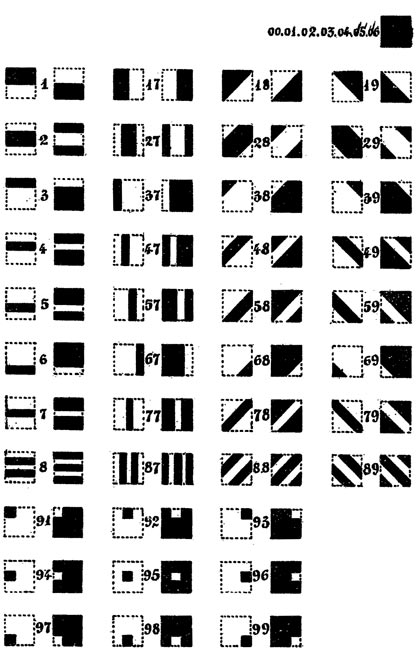
|
"The fundamental type is square and is designed to cover the whole surface of the sheet ; it is represented on the right upper part of the drawing by a black square, as in the drawing the full parts of the types are indicated inblack, parts which afterwards give different tints according to the ribbon on which they strike. To this fundamental full type, there corresponds a fundamental black type, not shown in the drawing, which serves to form the white grounds and is indicated by figure 0, the six tints of the fundamental type are indicated by figures 01, 02, 03, 04, 05, 06. "For all the other instances wherein a contour line, a delimitation of various tints and other particulars of the photograph fall within the ground of the type, are used derived types, as shown in the drawing... this system of the two reciprocal types allow to fill the place of one type with two different shades for, if, for instance, one strikes first the type on the right hand side of couple 96 with, say, No. 2 shade and then on the same place the type on the left hand size of the same couple with shades No. 5, on the whole will thereby be obtained..." "The complex of types shown as an example in the drawing includes : eight couples with horizontal stripes which are in the first column, shown by eight figures running from 1 to 8; eight couples with vertical stripes, numerated in order to facilitate one's memory, with a number of two figures of which the unit figure is always 7 and the tens figure changes from 1 to 8; eight couples with diagonal stripes running from below on the left side to the right upwards, indicated by two figures whose tens figure runs from 1 to 8 and whose unit is 8; eight couples with diagonal stripes running from above on the left side to the right downwards, indicated by two figures whose tens figure runs from one to eight and whose unit is 9; nine couples of 'punctiform' types wherein a square point occupies nine different positions shown with a number of two figures wherein the unit goes from 1 to 9 and the tens digit is always nine, viz,: with numbers 91 to 99.
|
|
The specification does not deal with the analysis — "exploration" or what would later be termed "scanning" — of the original image, and purposefully neglects "those electrical contrivances designed to effect automatically the direct transmission of images suitably prepared..." The system still employs a conventional telegraphic "figure" code, e.g., 3465 "shows a group of 5 characters, 3 formed with two tones, 4 and 6... and 5 shows that this character is to be repeated five times successively..." It provides a full elaboration of Ellero's system described in 1912/24,758 — in particular the combination of elementary signs into four-unit types. Here we have not only the "punctiform" units, but four others as well, for a quite full picture-reconstruction palette. No longer is Ellero writing of lead types, but now of a typewriter "supplied with the usual number of keys." The types are 2mm square, and set on the levers so as to type flush with the preceding and subsequent types. A shift mechanism permits "the successive impression of two or more different types in the same place," and a graduated system of tints (six described above) is obtained by the use of specially coloured ribbons..." Ellero's system — like others described here — presents increasingly elaborate means of capturing detail in the image, particularly with regard to edges. We might today call these algorithms for antialiasing. For all of the systems discussed here, the image (signal) processing — typically termed "analysis" — is not automated, but done by eye. We see no systematic attention to sample rate — this would come later (e.g., Ranger 1926). Ellero's elaborate system would be mooted by the incorporation of photocells in concert with, to borrow from 1932/404,715, "a plurality of electric discharge devices each resonsive to a different predetermined range of impressed current or voltage...to cause selective actuation of electromagnetic devices for controlling the selection of code combinations of electric signals in accordance with the aforesaid tone values." (1:47ff) That is to say, coding would remain a key aspect of asynchronous facsimile transmission (Bartlane and other systems), but the analysis and coding would be automated; moreover, elaborate mechanical printing devices would be eschewed for photochemical devices. It might be argued that "type" was a temporary and useful fiction, enabling engineers to focus on the sectioning and analysis of discrete areas of images so that they could be transmitted by start-stop (asynchronous) means, and even stored (on perforated tape) and made available for security "scrambling" by scrambling cams and other means. The Bartlane discussion further below moves us away from eyeball analysis of the image, and functions as a kind of coda to this brief episode in telegraphic ekphrasis.
|
UK Patent No 190,522
|
Method of and Means for Reproducing Pictures and the like, at a Distance by the use of a Signal Code |
Thomas Francis Gaynor (London) |

|
Gaynor's system focusses on analysis of value and hue, one x-y coordinate of an image at a time. He is not specific about mode of "reconstitution" beyond this — ...the operator proceeds with ink, pen, compass, stamp, type, or otherwise, to reproduce the tonal values upon a sheet of paper (preferably ruled with vertical and horizontal non-photographable, or erasable lines as previously mentioned to facilitate their quick and easy location and values, at their intersections) and then when the whole system of symbols has thus been plotted and marked in the sheet, the latter can be reduced to any desired size or degree required by photography... (3:124ff) Gaynor's system (which is not unique in this regard) transmits picture information — location of points, values and hues if any — in cipher code, whether by Morse, Creed or Western Electric (Murray) system. The five vowels represent the five tonal values — A / very light, E / light, I / grey, O / dark, and U / very dark. The two semi-vowels W and Y indicate white and black respectively. The first nine consonants (B, C, D, F, G, H, J, K, L) indicate the figures 1-9 and designate rows (x-coordinates), and the last nine consonants (N, P, Q, R, S, T, V, X and Z) indicate numbers 1-9 as well, but are used only "as coefficients of the total value symbols to designate the number of the latter which appear successively along a line or lines," but may also be used to "position tonal points or areas" in y-coordinates. (Vowels — conventionally being five in number — could be seized upon for special functions in telegraphic codes.) The vowels and semi-vowels may also be used for the "seven colours of the spectrum in the order in which both occur" : A for red, E for orange, I for yellow, O for green, U for blue, W for indigo, and Y for violet. Tints are indicated by suffixing to the color-vowel a second vowel indicating its tint, e.g., OE / light green. Gaynor's system condenses its message by indicating by cipher the number of successive x-y coordinates that will have the same tonal values and/or hues. Because it is these qualities that are expressed by vowels, it follows that vowels will be more frequently encountered than consonants. The system thus takes advantage of the fewer Morse telegraph key depressions that are required by vowels, and similarly by the more frequently encountered consonants. In an adumbration of the virtues of this code system, the specification notes that: "...these symbols are in record form, and can be easily corrected or proved, and a message in an emergency can be cut up and divided amongst several reproducers of the picture, to get out the complete picture as quickly as possible, as newspaper 'copy' is divided amonst several composition [sic] when it is necessary to obtain the complete article in type with the least loss of time... Gaynor maintains that coded intermediate records allow a number of operations relating to image processing (3:14ff). This approach to the "record" relates to both machine code condensers and encryption devices, that could be used both for text and various copying telegraphy.
|
UK Patent No 178,145
|
Improvements in and relating to the Telegraphic Transmission of Pictures. |
John Cameron Grant (Surrey) |

|
|
The diameters of half-tone dots are not graduated in steps; the issue here would be to assign discrete classifications to dots.
|
|
This specification offers two separate ideas. The first is a means of visually classifying halftone dots in a prepared (and enlarged) image in terms of their diameters, so that they may be coded and telegraphically transmitted. The second idea involves It appears that an operator would be required to analyze the diameter of the dots (using his grid). But no operator would be needed at the sending or receiving end to encode or decode the signals, that process being automated. It is a kind of analog process, not involving coding in any way. Soon, however, the use of photoelectric scanning mechanisms, yielding coded descriptions of images, would moot this idea. Halftone engravings would not play a role in this. The transmitted signals, whose length indicates size of their respective dot, actuate at the receiving end either a printing or a preferred punching mechanism. The punched card is "then fixed on a surface having a colour in strong contrast to that of the paper or card, thus producing an enlarged picture which may be reduced photographically to any required size. Or the reduced reproduction may be obtained by acting on a photographic plate by light transmitted through the perforated paper or card." (4:115ff) Grant alludes to the mechanical process of placing "dots of the correct size in the relative positions which have been communicated to him and thus the picture is produced dot by dot at the receiving end." (3:10ff) His objective is to streamline the process. His first idea (the screen by which dots are classified) seems suited to a process he wishes to leave behind with his second idea. The second idea (involving a relief block of dots) would in principle continue for decades to come, but the Bartlane and other systems of photoelectric cell scans, and the use of five, six and more unit perforated tape either for coded transmission and even as part of a shutter system, would prove superior to Grant's idea. I include it here as part of the discussion of elementary signs for picture transmission and reconstitution, and also to acknowledge Grant's involvement in this area as well as telegraphic printing of letters. Related Grant patents (cited in this specification) included : 1921 GB 172,374 "Improvements in means for transmitting messages" and 1921 GB 191,430 "Improvements in and relating to the telegraphic transmission of pictures." Specification 191,430 is an improvement on 178,145, by obviating the need to create an enlarged process block.
|
|